- Home
- Media Kit
- Current Issue
- Past Issues
- Ad Specs-Submission
- Ad Print Settings
- Reprints (PDF)
- Photo Specifications (PDF)
- Contact Us

![]()
ONLINE


FUNDESA President Felipe Bosch
Guatemala’s FUNDESA
If you were to stop someone on the street and ask, “Can you tell me about Guatemala?” the chances are you wouldn’t get back a lot more than this: “Beats me! It’s somewhere down there in the south, right?”
In fact, Guatemala is one of the largest and most economically promising nations in Central America, stretching from Mexico in the northwest to Honduras and El Salvador in the east. Having more than 42,000 square miles within its borders, it is almost as large as Ohio, and has an even larger population (16 million people in Guatemala versus 11.5 million in Ohio).
But that’s where the similarities with Ohio end – and where the opportunities (and challenges) of Guatemala begin. With its rich cultural history, Guatemala is (or at least it could be) one of the great tourist draws of the Americas. Even though the homicide rate has dropped by over 30 percent over the past five years, it is still one of the most crime-infested nations on earth, with a murder rate roughly on par with Colombia, and a thriving cross-border trade in human smuggling and drug trafficking – much of which affects the U.S.

Members of the FUNDESA Board and
its Intercultural Commission meet with
the Indigenous Authorities of Sololá.
There is, however, one philanthropic organization known as The Foundation for the Development of Guatemala (FUNDESA), which has worked tirelessly, both in Guatemala and in Washington, D.C., to transform Guatemala into a land of hope and opportunity in the future instead of one filled with little but misery that it is today. And given the obstacles they’ve overcome and the accomplishments they’ve racked up to date, the people of FUNDESA are presenting a national proposal to speed up change following a road map that proposes a social, economic, and institutional development model that both governments (national and local) and philanthropic organizations throughout the developing world can use as examples to replicate.
FUNDESA’s president, Felipe Bosch (Board Member of Multi-Inversiones, a family firm with six divisions but that is best known around the world for its Pollo Campero restaurant chain) offers the following thumbnail sketch of the organization’s goals – and how far FUNDESA has come in their efforts to date.
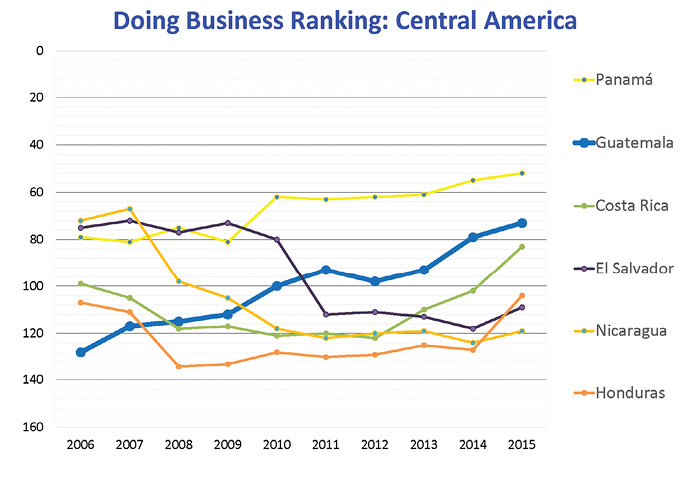
Guatemala improved 19 positions
in
the global ranking of Doing
Business from 2013-2014
A National Consensus Development Agenda
Our basic game-plan for the past six years has been to destroy the outdated stereotype of Guatemala as a polarized nation driven by the clash between social classes, ethnic groups, and ideologies, and replace it with the reality of a proactive private sector driving nationwide dialogue and consensus towards promoting inclusive development for all Guatemalans. We are apolitical and have worked with all of the political parties, as well as national and international leaders who are willing to work with us.
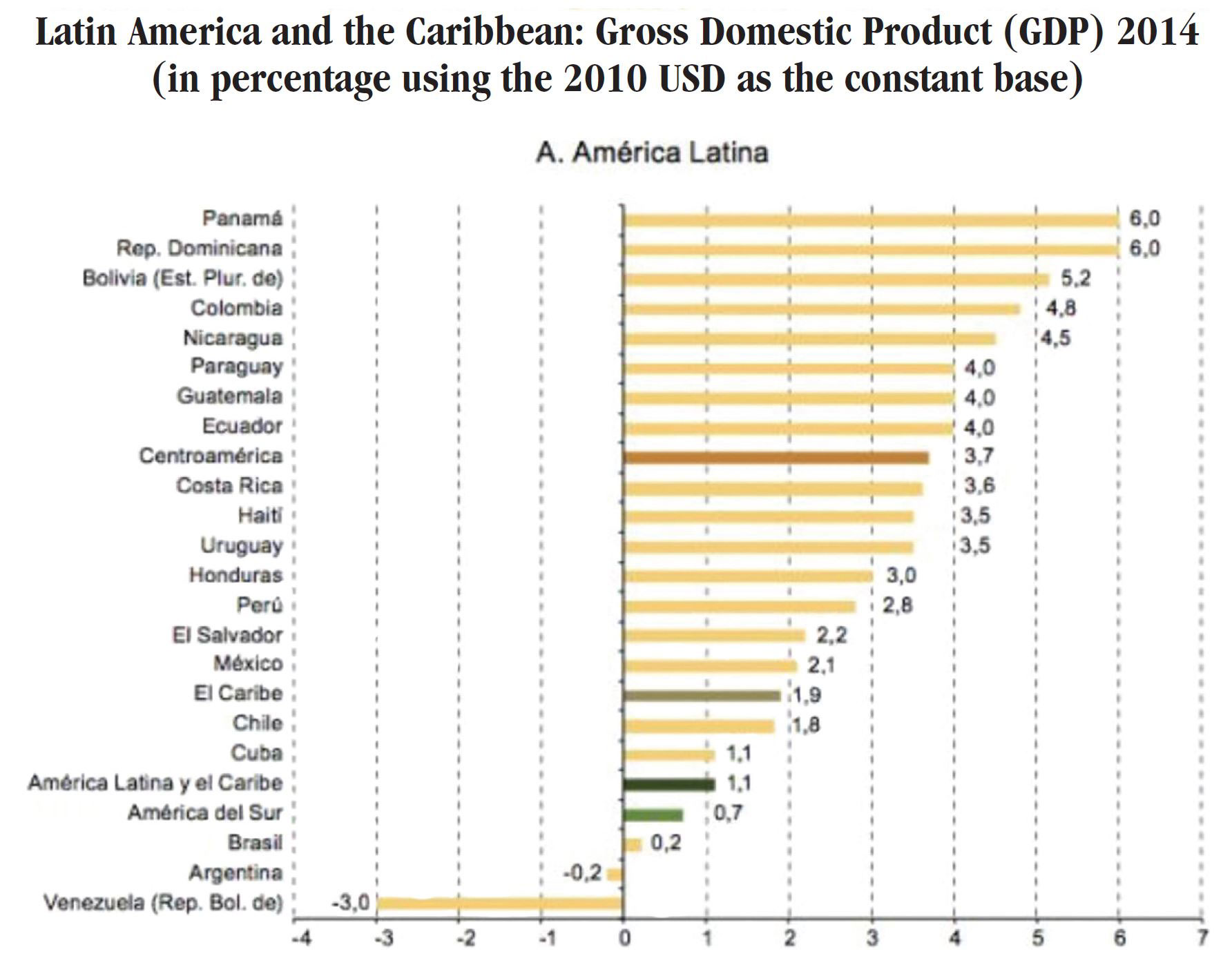
Guatemala’s economy grew to 4 percent
in 2014 to
better rates than most of
Latin America’s economies in the
same period
Much of the work has been guided by the technical guidance of Professor Ricardo Hausmann of Harvard University, and the Dalberg Global Development Advisors Group in 2011.
FUNDESA, working closely with CACIF (the national private sector organization that coordinates all business chambers) under the Mejoremos Guate umbrella, has taken the growth-constraints diagnostic work and designed a series of strategies to address those constraints. It has put actions in motion through a privately funded portfolio of projects and initiatives grouped under four strategic pillars: prosperity, security, solidarity, and institution building. The efforts and collaboration with the current government administration have led to short-term impact projects with promising job creation in the medium and long term. This includes the National Agency for Project Structuring, which produces large-scale infrastructure investment opportunities, reactivation of Social Housing construction that will produce 10,000 direct and indirect jobs per year. A Liquid Natural Gas agreement with Mexico will dramatically reduce the cost of energy and electricity. The question now is how to assure the continuity of these efforts given the uncertainties surrounding the upcoming elections in September.
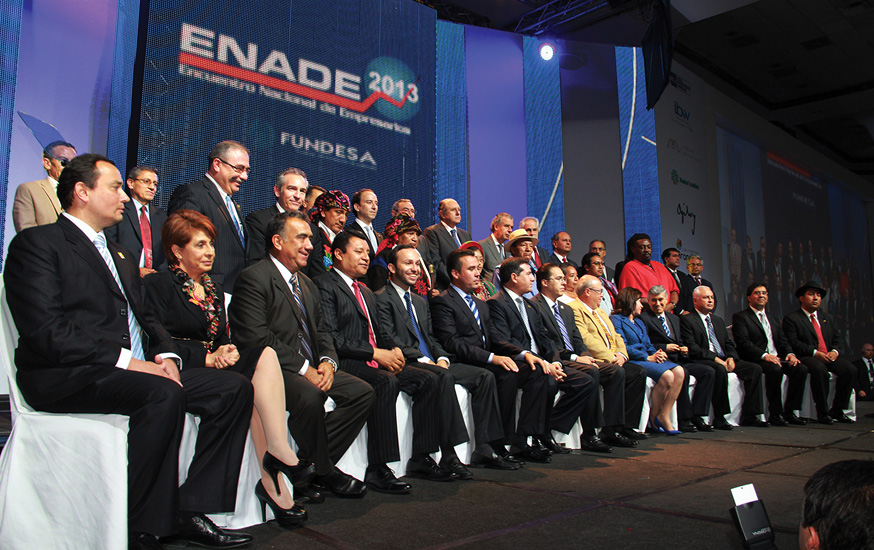
During FUNDESA’s “ENADE 2013,”
members of 13 political parties with
representation
in Guatemala’s congress
sign the First National Accord for
Human Development. Representatives
from the diplomatic community, indigenous
and civil society leaders, served as
honorary witnesses to the historic moment.
FUNDESA recognizes that driving such an ambitious agenda for inclusive growth required support from friends in the international community. To that end, they targeted, among other areas, Washington D.C. – and in particular the State Department and the key committees of Congress – to advance a new approach to foreign aid. This involves partnering around a locally supported development agenda to replace the traditional model of shoveling out money to existing local entities and NGOs in the recipient country. The international cooperation in Guatemala and, in particular with the U.S. Government, has also learned its lessons the hard way by investing taxpayer dollars in models that failed to generate results. Ultimately, the models proved unsustainable, largely because they didn’t engage in consensus-building strategies with all relevant actors nationwide (public, private, and international cooperation).
Social Objectives
At the time of its founding in 1984, FUNDESA set a seemingly unattainable goal of improving the quality of Guatemalan education. At the beginning of the millennium, the national illiteracy rate was 32 percent, with even higher rates in rural areas where women only completed 1.4 years of school compared to 2.4 years for the overall population. In 2005, only 6 percent of children in sixth grade passed standard reading and math tests. Over the course of 15 years, Guatemala has progressed from having one of the worst educational systems in the region to approaching the average performance indicators in Latin America, as measured by the recent TERCE regional study by UNESCO.
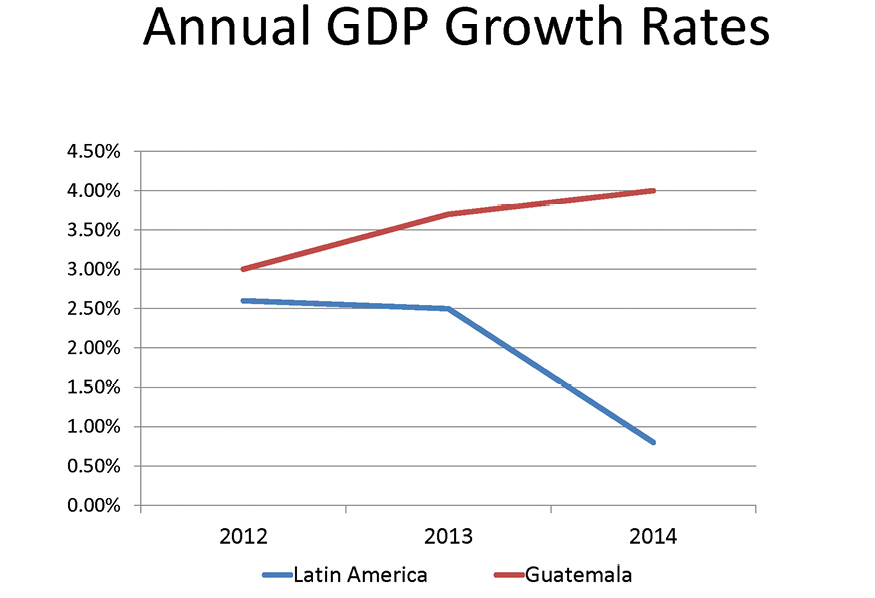
Guatemala begins to takeoff as
its rate of growth accelerates
despite the regional slow-down
being experienced in Latin America.
Specific projects include the launching of a technological platform with “Empresarios por la Educación” (Entrepreneurs for Education), whereby citizens are empowered to monitor and report if their schools are open. This crowdsourced approach is proving quite valuable towards assuring that kids receive the minimum 180 days of class per year.
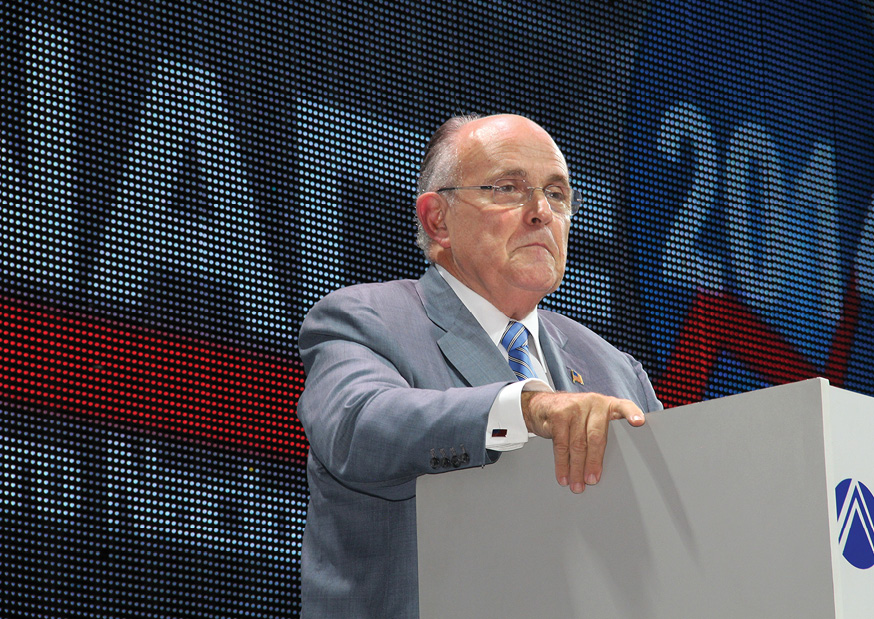
Mayor Giuliani shares experiences of
New York’s Safe City
model and his
views on FUNDESA’s Security and
Justice roadmap during ENADE 2014.
“Equally important as a binding constraint to the national development is the issue of Child Chronic Malnutrition,” stated Alvaro Castillo, a member of FUNDESA’s board. Castillo has been active in the promotion of the Alliance for Nutrition, an effort to exercise social pressure on the government to provide adequate health services to the most poor and vulnerable population. It works to define a standard intervention model to effectively reduce the appalling 49.8 percent proportion of children under five who suffer from chronic malnutrition in the country. “Their ability to learn is stunted by the lack of nutrients to the brain during critical developmental phases during the first 1,000 days of life, and our efforts will allow us to not only coordinate multi-sectorial actions but also monitor progress,” concluded Castillo.
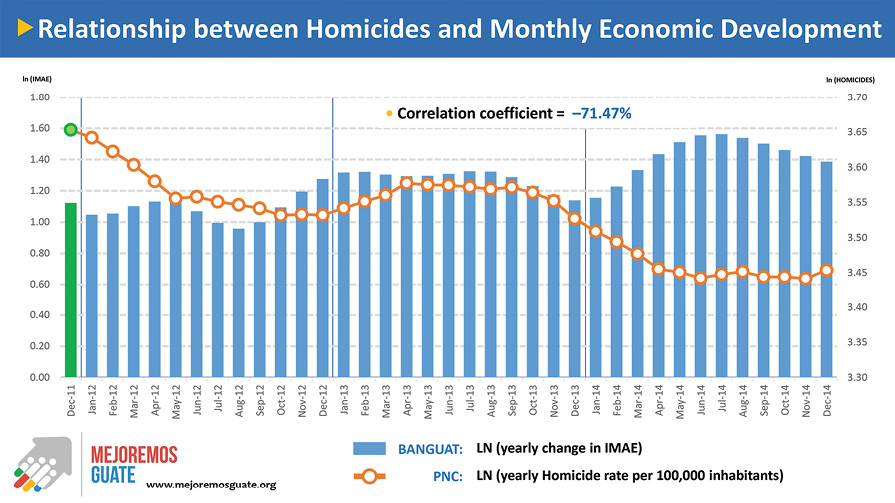
There is a correlation between reduction
of homicide rates and economic
performance, as shown. Every 10 percent
homicide reduction improves 1 percent
on annual GDP.
Citizen Security
“Mayor Giuliani, in his speech at our event in October 2014, suggested that we have to solve security concerns first and that job creation will follow. We have been heeding his advice,” reflected Juan Monge, another member of FUNDESA’s board, who is also responsible for the Citizen Security & Justice Coalition. This approach is not surprising given that insecurity today represents a national cost of roughly 8.7 percent of GDP (as per the Institute of Economics and Peace 2014), placing Guatemala at the very bottom of the World Economic Forum Index on the cost of doing business due to insecurity.
Monge continued, “Even though Citizen Security is a responsibility of the government, we have studied and deployed a series of initiatives to strengthen Security and Justice institutions, to promote necessary changes to national legislation and, finally, to empower citizens through technology. We inherited a culture of fear caused by so much violence in the past four decades. With the use of technology, we are enabling the citizens’ participation in reporting criminal events via the Alertos mobile App. Having real-time data creates a spillover effect in neighborhood policing, more presence, and coordinated preventive strategies.” The proof is in the pudding and a drop of over 30 percent in homicide rates in five years is astounding. The Coalition is now focused on supporting the national policy in reducing extortion and hopes to deliver even more ambitious results.

Members of FUNDESA’s Intercultural
Commission reflect on mechanisms to
improve the quality of life for indigenous communities in rural Guatemala.
Overarching Objectives
Jose Miguel Torrebiarte, a Vice President of FUNDESA, commented, “Few aspects of Guatemalan life mark it as more of a backward country than the huge percentage of the country’s population – most of them women – who live subsistence-level lives.” In 2011, FUNDESA set the goal of bringing two million of these people – roughly 13 percent of the country’s entire population – out of poverty by the year 2021. Since that time, poverty rates have fallen from 53.7 percent to approximately 49.6 percent. The creation of more jobs at a faster pace requires integrating efforts that will bring development and opportunities to more Guatemalans living in rural areas of our country. This is why enabling the market conditions, with clarity on the potential economic drivers and the territories they will impact, is a cornerstone for bringing investments and income generation to otherwise poor and stagnated regions.
Bringing two million people out of poverty is a very ambitious goal and FUNDESA recognizes that it is but one actor in an otherwise fragmented country. However, by trying to bring together a nation around a clear set of priorities, by providing technical research to drive evidence-based approaches, and by stimulating inclusive dialogue, it has been successful in bringing about the necessary foundation for development. A key component has been the support of the local business community, which has invested over $12.5 million to support everything from drafting research papers on fiscal policy to the development of Citizen Empowerment Apps.
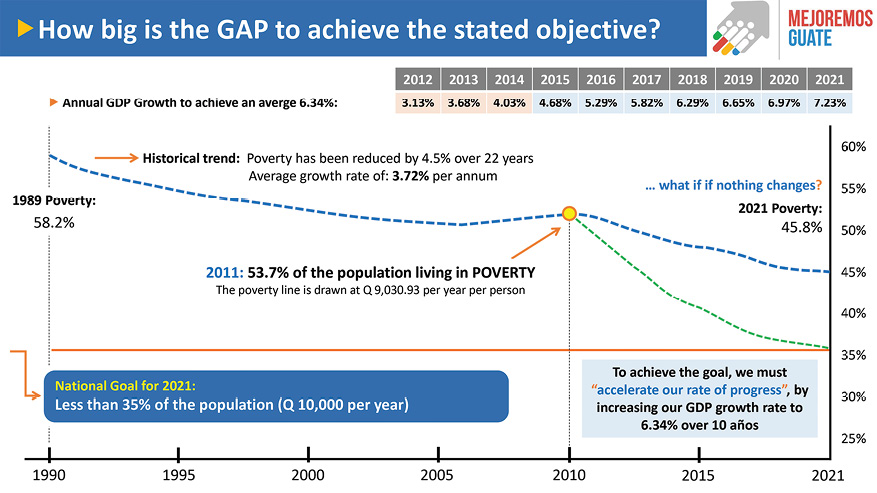
A visualisation of what success looks like:
accelerating the rate of development
in order to reduce poverty
to 35 percent
by Guatemala’s bicentennial in 2021.
Lessons For The U.S.
As FUNDESA’s initiatives show, U.S. goals and interests are best served by partnering with Central American countries around long-term development agendas rather than squandering resources on short-term, border-closure projects. The U.S. has its own very legitimate needs to reduce illegal migration as well as reduce human and drug trafficking. The FUNDESA model shows that how to meet this goal is not through building legal and literal walls at borders but by generating systemic change within the target countries. The simple lesson for everyone, “Help make home a desirable place to stay and no one will want to leave,” has been summarized by Salvador Paiz, Vice President of FUNDESA and one of the early instigators of the Mejoremos Guate umbrella strategy.
U.S. Senator Daniel Patrick Moynihan once said, “Everyone is entitled to his own opinion, but not his own facts.” The fact is that Guatemala is changing at a rapid pace. Local actors have invested and will continue to invest in creating an impactful agenda to drive inclusive development. Chances are that if the economy is properly stimulated, it can explode into a booming import market for consumer goods from around the world. Addtionally, it can become a growing manufacturing hub for an array of high-value-added products being exported from Guatemala. The fact is that Guatemala is coming together around a national development agenda and is achieving some very interesting results. Now that you know where Guatemala is and what is happening there, the only question is: Why are you waiting to jump on board?•